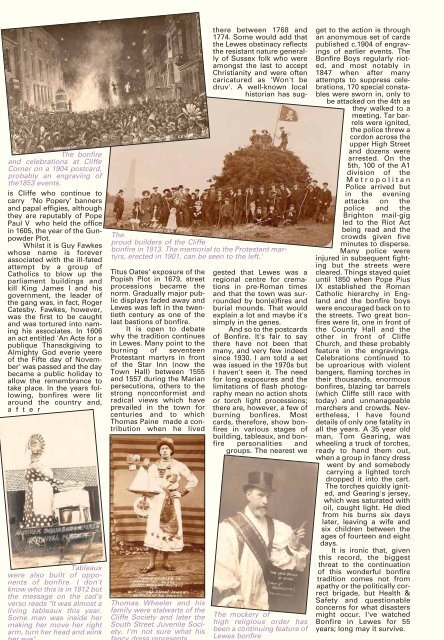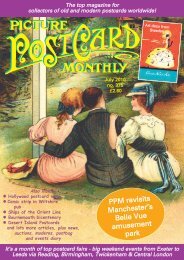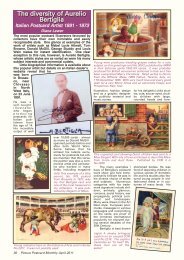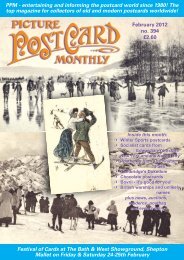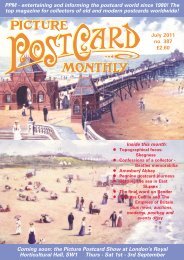Would you pay £1,000 for this post- card? - Picture Postcard Monthly
Would you pay £1,000 for this post- card? - Picture Postcard Monthly
Would you pay £1,000 for this post- card? - Picture Postcard Monthly
- No tags were found...
Create successful ePaper yourself
Turn your PDF publications into a flip-book with our unique Google optimized e-Paper software.
The bonfireand celebrations at CliffeCorner on a 1904 <strong>post</strong><strong>card</strong>,probably an engraving ofthe1853 events.is Cliffe who continue tocarry ‘No Popery’ bannersand papal effigies, althoughthey are reputably of PopePaul V who held the officein 1605, the year of the GunpowderPlot.Whilst it is Guy Fawkeswhose name is <strong>for</strong>everassociated with the ill-fatedattempt by a group ofCatholics to blow up theparliament buildings andkill King James I and hisgovernment, the leader ofthe gang was, in fact, RogerCatesby. Fawkes, however,was the first to be caughtand was tortured into naminghis associates. In 1606an act entitled 'An Acte <strong>for</strong> apublique Thansckgiving toAlmighty God everie yeereof the Fifte day of November'was passed and the daybecame a public holiday toallow the remembrance totake place. In the years following,bonfires were litaround the country and,a f t e rTableauxwere also built of opponentsof bonfire. I don'tknow who <strong>this</strong> is in 1912 butthe message on the cad'sverso reads "It was almost aliving tableaux <strong>this</strong> year.Some man was inside hermaking her move her rightarm, turn her head and winkher eye".Titus Oates’ exposure of thePopish Plot in 1679, streetprocessions became thenorm. Gradually major publicdisplays faded away andLewes was left in the twentiethcentury as one of thelast bastions of bonfire.It is open to debatewhy the tradition continuesin Lewes. Many point to theburning of seventeenProtestant martyrs in frontof the Star Inn (now theTown Hall) between 1555and 1557 during the Marianpersecutions, others to thestrong noncon<strong>for</strong>mist andradical views which haveprevailed in the town <strong>for</strong>centuries and to whichThomas Paine made a contributionwhen he livedTheproud builders of the Cliffebonfire in 1913. The memorial to the Protestant martyrs,erected in 1901, can be seen to the left.'Thomas Wheeler and hisfamily were stalwarts of theCliffe Society and later theSouth Street Juvenile Society.I'm not sure what hisfancy dress represents.there between 1768 and1774. Some would add thatthe Lewes obstinacy reflectsthe resistant nature generallyof Sussex folk who wereamongst the last to acceptChristianity and were oftencaricatured as 'Won't bedruv'. A well-known localhistorian has suggestedthat Lewes was aregional centre <strong>for</strong> cremationsin pre-Roman timesand that the town was surroundedby bon(e)fires andburial mounds. That wouldexplain a lot and maybe it'ssimply in the genes.And so to the <strong>post</strong><strong>card</strong>sof Bonfire. It's fair to saythere have not been thatmany, and very few indeedsince 1930. I am told a setwas issued in the 1970s butI haven't seen it. The need<strong>for</strong> long exposures and thelimitations of flash photographymean no action shotsor torch light processions;there are, however, a few ofburning bonfires. Most<strong>card</strong>s, there<strong>for</strong>e, show bonfiresin various stages ofbuilding, tableaux, and bonfirepersonalities andgroups. The nearest weThe mockery ofhigh religious order hasbeen a continuing feature ofLewes bonfireget to the action is throughan anonymous set of <strong>card</strong>spublished c.1904 of engravingsof earlier events. TheBonfire Boys regularly rioted,and most notably in1847 when after manyattempts to suppress celebrations,170 special constableswere sworn in, only tobe attacked on the 4th asthey walked to ameeting. Tar barrelswere ignited,the police threw acordon across theupper High Streetand dozens werearrested. On the5th, 100 of the A1division of theMetropolitanPolice arrived butin the eveningattacks on thepolice and theBrighton mail-gigled to the Riot Actbeing read and thecrowds given fiveminutes to disperse.Many police wereinjured in subsequent fightingbut the streets werecleared. Things stayed quietuntil 1850 when Pope PiusIX established the RomanCatholic hierarchy in Englandand the bonfire boyswere encouraged back on tothe streets. Two great bonfireswere lit, one in front ofthe County Hall and theother in front of CliffeChurch, and these probablyfeature in the engravings.Celebrations continued tobe uproarious with violentbangers, flaming torches intheir thousands, enormousbonfires, blazing tar barrels(which Cliffe still race withtoday) and unmanageablemarchers and crowds. Nevertheless,I have founddetails of only one fatality inall the years. A 35 year oldman, Tom Gearing, waswheeling a truck of torches,ready to hand them out,when a group in fancy dresswent by and somebodycarrying a lighted torchdropped it into the cart.The torches quickly ignited,and Gearing's jersey,which was saturated withoil, caught light. He diedfrom his burns six dayslater, leaving a wife andsix children between theages of fourteen and eightdays.It is ironic that, given<strong>this</strong> record, the biggestthreat to the continuationof <strong>this</strong> wonderful bonfiretradition comes not fromapathy or the politically correctbrigade, but Health &Safety and questionableconcerns <strong>for</strong> what disastersmight occur. I've watchedBonfire in Lewes <strong>for</strong> 55years; long may it survive.<strong>Picture</strong> Post<strong>card</strong> <strong>Monthly</strong> November 2009 17


